Thame, Oxfordshire
Up to 1834
Thame had a workhhouse from 1726. In 1763-4 the churchwardens advertised for a suitable person to run the workhouse. By 1776, the workhouse occupied part of the town's 'bridewell' or local prison, on Pound Lane, now Wellington Street. In 1790, after the bridewell had ceased operation, the whole building was bought by the parish for workhouse use. The building later burnt down. The former Wellington public house later stood on the site.
In 1776, a workhouse was also in operation at Brill.
After 1834
Thame Poor Law Union was formed on 16th September 1835. Its operation was overseen by an elected Board of Guardians, 38 in number, representing its 34 constituent parishes as listed below (figures in brackets indicate numbers of Guardians if more than one):
Oxfordshire:
Adwell, Albury, Ascott, Aston and Kingston, Chalgrove, Crowell, Easington, Emmington, Great Haseley with Little Haseley, Great Milton with Chilworth, Lewknor with Postcomb, Lewknor-up-Hill,
Little Milton, Shirburn, South Weston, Stoke Talmage, Sydenham, Tetsworth, Thame (3), Thornley, Tiddington,
Warpsgrove, Waterstock, Waterperry, Wheatfield.
Later Additions: Attington, Chinnor (from 1897).
Buckinghamshire:
Brill (2), Chilton, Dorton, Ickford, Kingsey, Long Crendon (2), Oakley,
Shabbington, Worminghall.
Later Additions: Boarstall (from 1905), Granborough (1837-45).
The population falling within the union at the 1831 census had been 14,546 with parishes ranging in size from Easington (population 13) to Thame itself (2,885). The average annual poor-rate expenditure for the period 1833-35 had been £19,101 or 26s.8d. per head.
The new workhouse was built in 1836 to a design by Witney-born George Wilkinson on a site at the north-west of Thame on the north side of the Oxford Road. It was designed to accommodate 350 people and cost around £7,000. The site layout is shown on the 1898 map below.
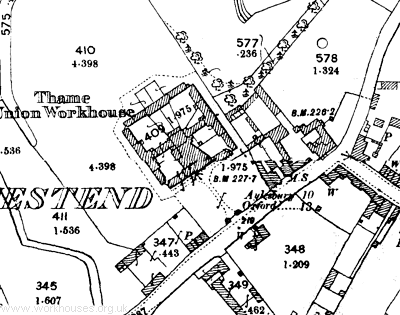
Thame workhouse site, 1898.
Wilkinson designed several other workhouses in the area including Chipping Norton and Witney. His design for Thame broadly followed the popular cruciform or "square" design.
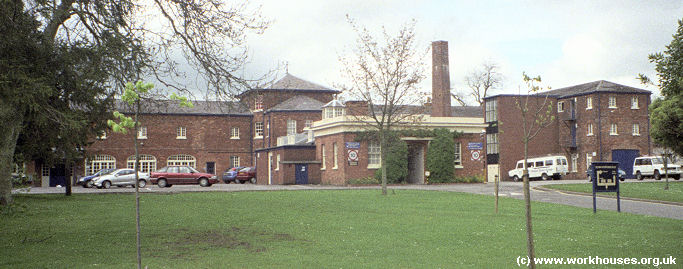
Thame general view from south-west, 2000.
© Peter Higginbotham.
The building was constructed in red brick with slate roofs. From the central three-storey hub, which originally housed a chapel and men's dining-hall, two-storey wings radiated to the east and west, each terminating in three-storey blocks running north-south. The upper floors of the hub contained the Master's quarters and had windows providing views in all directions over the inmates' yards.
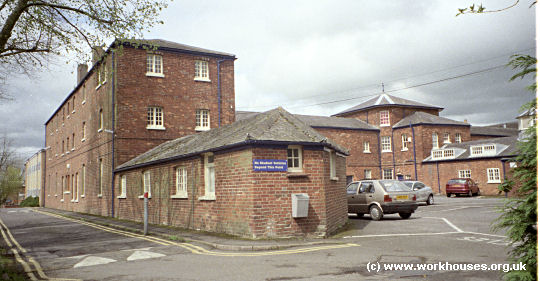
Thame view from south-west corner, 2000.
© Peter Higginbotham.
South from the central hub lay a single-storey range, which originally housed the workhouse kitchens. Unusually, there was no corresponding range to the north of the hub.
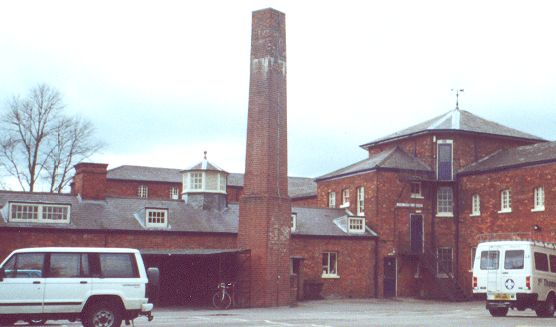
Thame central hub and kitchen block from the south-east, 2000.
© Peter Higginbotham.
The main entrance to the site was flanked by two "pepper-pot" gate houses.
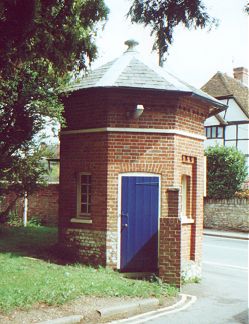
Thame gate house from north-west, 2000.
© Peter Higginbotham.
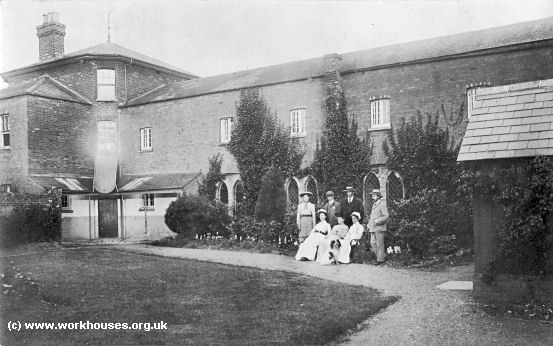
Outside the chapel, c.1910.
© Peter Higginbotham.
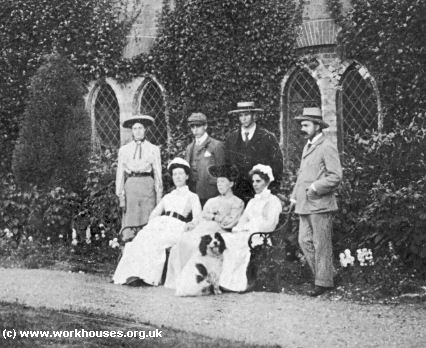
Outside the chapel (detail), c.1910.
© Peter Higginbotham.
Many aspects of life in the workhouse were the subject of regulations from the central Poor Law Commissioners in London. For example, in 1836 the diet of Thame's inmates was laid down.
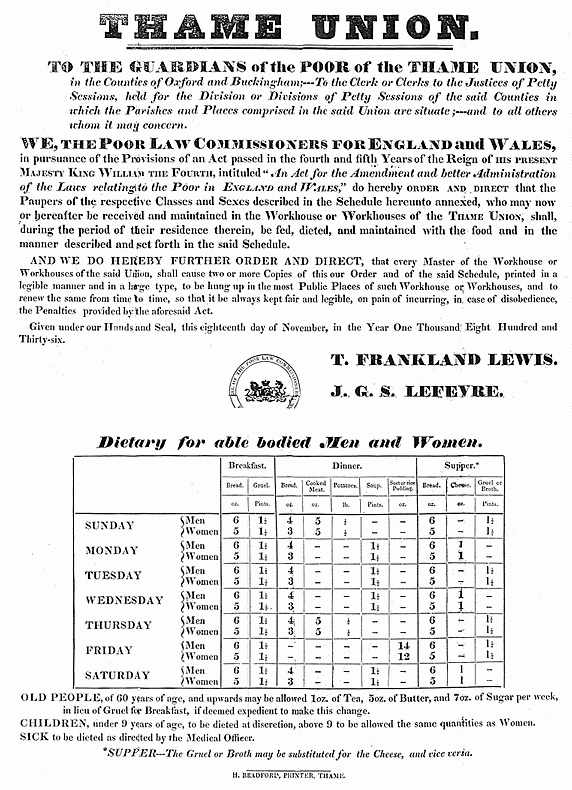
Thame workhouse dietary, 1836.
One exception to this monotonous regime came at Christmas, an occasion which was regularly reported in the local press.
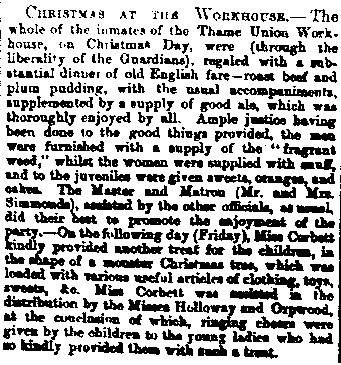
Thame workhouse Christmas, 1879.
In 1931, former Oxford MP Frank Gray recorded his undercover experiences in the casual wards of Oxfordshire workhouses which he visited disguised as a tramp. Of Thame he wrote:
The gates open; we walk up the garden. A clerk takes particulars under a lamp at the front door, and we pass to the back, isolated from the higher grade of the workhouse, the permanent inmates. We shamble into this workhouse from the outer world, and then past the quarters of the permanent inmates to our den at the back midst the refuse heaps, wellnigh like lepers-the unclean.
I made a slip as I gave my answers, for I noticed the clerk momentarily start as he detected a pitch of voice unusual in a casual ward. I must be more careful thereafter.
In the Thame workhouse there is no strict search; there is no suggestion of a bath or a wash. We retain our clothes and sleep in some of them. To-night I have a pillow - my boots with my trousers wrapped over them. We sleep on boards on a gradient raised from the floor, and the slope helps sleep.
As we arrived at this workhouse and answered the stereotyped questions - as listlessly as they were asked - we received our hunk of bread, and with it we said good-bye to all officialdom and supervision and entered the casual ward. As the tramps have lost heart so have the officials.
Here the casual ward is a long narrow apartment with an overflow department upstairs. In the apartment I am in downstairs there is a sort of ante-room, just big enough for three; it is the antechamber of the lavatory - indeed it is part of the unsavoury arrangement whereby a tramp may wash, if he has not already lost heart and realized that in the general discomfort and squalor cleanliness has lost its meaning and its values.
Here, unclean and unhappy, I lie in a chamber already the home of body vermin and house vermin. With such hospitality as this, what do I owe to society?
So thinks the tramp, to whom society accords no future and no dawn.
I get into this ante-apartment with two other tramps. Of these, one has given his age as sixty-seven, and the other as eighty-four years. The first is "Bill," and the other "Dad." I don't think the latter is eighty-four, but think of him - if he is only seventy-four - aimlessly wandering through the sewers of society to reach no terrestrial home! This poor old man may be to blame - society must be.
He tells me he was once in the Oxford "spike" for six months as a permanent inmate, although they had not been able to establish any "settlement" by birth or residence. You can't in a tramp of sixty years.
You do not know his real name. Nor does he! He says he left Oxford because all the others had their local friends who left them little "delicacies," or money to buy delicacies. It seemed terrible to him to watch others have little delicacies like tobacco and to be denied himself. He could not stand it, and took again to the "open road." Afterwards I am to sleep in two other "spikes" with "Dad." All the officials are particularly good to him. "Bill" is a fund of information and deep cunning. He talks much to me before going to sleep. He opens the conversation as he crowds in to lie beside me, with a sniff and the words: "There are bugs in the walls here; I can smell them." He is right, for in fact at this time this casual ward is dirtier than the dirty men who use it.
In the 1930s, after the building's use as a workhouse had ended, it lay empty for a number of years, then was brought back into use as a school for the sons of deprived families from the north-east of England. In the late 1950s, the school was given to Oxfordshire County Council to run as a residential technical college specialising in agricultural engineering. Rycotewood College continued in operation until around 2004 but is now being redeveloped with part of the original building being preserved.
Staff
Inmates
Records
Note: many repositories impose a closure period of up to 100 years for records identifying individuals. Before travelling a long distance, always check that the records you want to consult will be available.
- Oxfordshire History Centre, St Luke's Church, Temple Road, Cowley, Oxford OX4 2EX. Limited holdings include: Guardians' minute books (1835-1928); Dietary (1836); etc.
Bibliography
- Gray, F. (1931) The Tramp: His Meaning and Being JM Dent.
Links
- None.
Unless otherwise indicated, this page () is copyright Peter Higginbotham. Contents may not be reproduced without permission.


